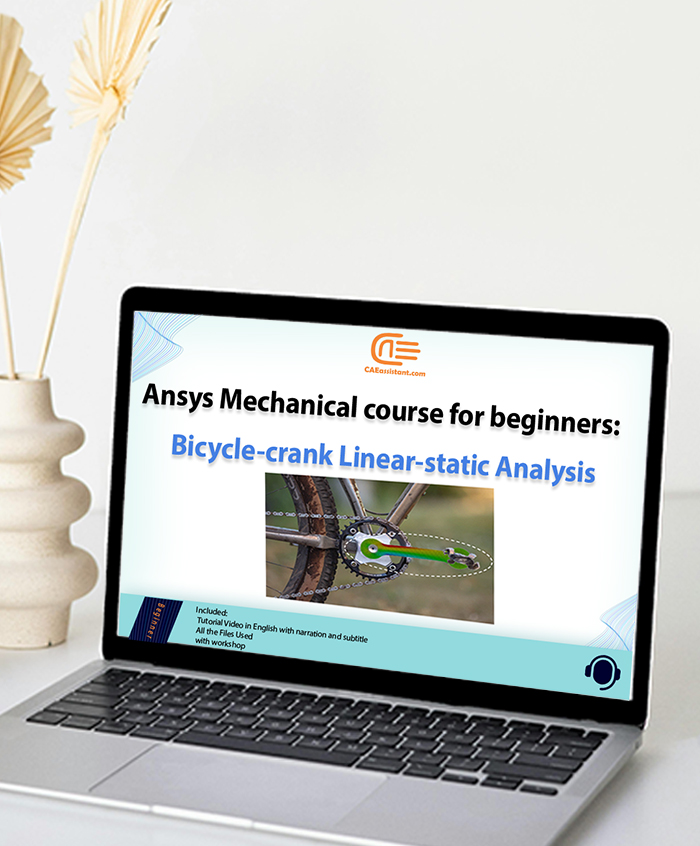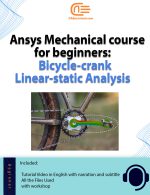Introduction to Bicycle Stress Analysis | Case Study: Bicycle Crank Stress Analysis
A bicycle crank plays a pivotal role in converting a rider’s pedaling force into rotational motion, acting as a lever arm to amplify the rider’s effort. As the rider applies force to the pedals, the crank rotates, driving the sprocket wheel and ultimately propelling the bicycle forward. Through this bicycle stress analysis, we aim to ensure that our design will be safe under the various loading conditions that may arise during cycling, verifying its durability and performance.
In this tutorial, we will explore the linear-static analysis of a bicycle crank. The crank, made of Aluminum 6061-T6, will be analyzed using Ansys Mechanical – a leading FEA tool known for its precision, power, and ease of use. This course is designed to equip beginners with the knowledge to perform simulations and analyze structural behavior efficiently. The user will go through the essential steps in finite element analysis (FEA), including the model setup, simulation, and interpretation of results.
Importance of Linear Static Analysis
Linear-static analysis occupies a crucial role within the diverse landscape of finite element analysis (FEA), including applications like bicycle stress analysis. Its assumptions of constant loads and small deformations, coupled with linear material behavior, lead to computationally efficient solutions compared to more complex nonlinear or dynamic analyses. This efficiency makes it particularly valuable in the early stages of design, allowing engineers to rapidly assess the feasibility of various concepts and identify potential weaknesses.
Furthermore, linear-static analysis serves as a foundational stepping-stone for more advanced investigations. The stress and deformation results obtained from such analysis can inform subsequent fatigue life predictions, optimization studies (e.g., topology or shape optimization), or even serve as initial conditions for nonlinear analyses where deviations from linearity are anticipated. In essence, the importance of linear-static analysis lies in its ability to provide valuable insights into structural behavior with a balance of accuracy, computational cost, and practical applicability across a broad spectrum of engineering domains.
Benefits of Ansys Mechanical for FEM Analysis
Ansys Mechanical stands out among FEA software for its intuitive user interface, robust solver technology, and comprehensive post-processing capabilities, making it ideal for tasks such as bicycle stress analysis. Compared to its competitors, Ansys excels in:
- Ease of Use: Its streamlined workflow allows even beginners to perform advanced simulations without extensive training.
- Mesh Flexibility: With features like local mesh refinement and mesh independence checks, users can ensure accurate results with optimized computational resources.
- Powerful Solvers: Ansys is known for its fast and reliable solvers, which handle complex simulations with ease.
- Comprehensive Analysis Tools: The post-processing tools in Ansys provide in-depth insights into stress, deformation, and safety, making it an ideal tool for both preliminary and advanced structural assessments.
Step-by-Step Simulation Methodology of Bicycle Crank Stress A
- Importing Geometry
The bicycle crank geometry, available as a CAD model in STEP (.stp) format, is imported into Ansys Mechanical. The crank is modeled with dimensions suited to real-world cycling conditions, forming the basis for the Bicycle Crank Stress Analysis.
- Material Properties
Aluminum 6061-T6, a lightweight yet durable material commonly used in bicycle components, is assigned as the material. The material properties, including a Young’s modulus of 1×10⁷ psi and a Poisson’s ratio of 0.33, are crucial for ensuring the accuracy of the simulation results, particularly when calculating stress and deformation under load.
- Meshing Process
Meshing is a critical step in the Bicycle Crank Stress Analysis, and a hex-dominant mesh is generated using different meshing features in Ansys Mechanical for higher accuracy. A local mesh refinement is applied, particularly around areas of interest such as holes and fillets. The crank model contains approximately 7000 elements and 35000 nodes, with careful attention to mesh-quality parameters like element quality and skewness to ensure a high-quality mesh.
- Defining Boundary Conditions
Boundary conditions are key in simulating real-world constraints and forces. In this case, a fixed support is applied at one hole surface of the crank, while a 110 lbf downward force is applied to the opposite end. These conditions mimic the forces experienced by a crank during normal cycling operation.
- Solving and Post-Processing
Once the setup is complete, the analysis is performed, and the results are post-processed using Ansys Mechanical’s built-in tools. The following results are obtained:
- Total deformation shows that the crank deforms minimally (~0.04 in) under the applied load, with the largest deformation occurring at the free end.
- Bending stress distribution (sigma_x) indicates that the crank experiences both tension and compression. Maximum stress (~11,700 psi) occurs at the fillet region, with some stress concentrations around the fixed hole of the crank as well.
- The Factor of Safety (FOS) is calculated using the Von Mises stress criterion, with a minimum FOS of 3.2, confirming the crank’s structural integrity under operational loads.
Validation with Hand Calculations
To enhance confidence in the simulation results, a validation step is performed using hand calculations. In this Bicycle Stress Analysis, the bending stress, calculated using the flexure formula, is compared to the Ansys results, showing close agreement (~0.001% difference). This close match confirms the accuracy of the FEA simulation.
Mesh Convergence Study
Conclusion
This tutorial provides a detailed walkthrough of the linear-static analysis of a bicycle crank using Ansys Mechanical, focusing on Bicycle Stress Analysis. By following the steps outlined in this package, users will gain practical experience in setting up simulations, applying boundary conditions, generating meshes, and interpreting results with confidence. Ansys Mechanical proves to be a powerful tool for FEM analysis, offering flexibility and precision in structural simulations.
Whether you’re a beginner looking to get started with FEA or an experienced engineer seeking to refine your skills, this package provides a strong foundation in the fundamental techniques needed to succeed in real-world applications.





Reviews
Clear filtersThere are no reviews yet.